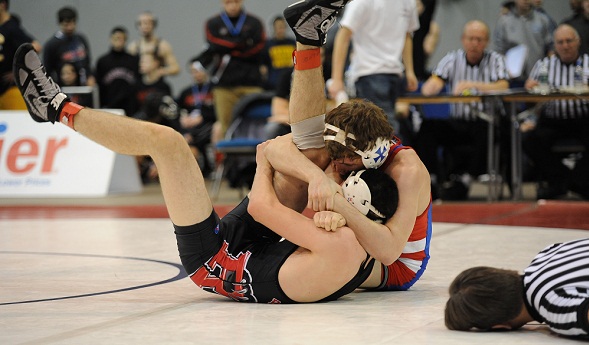
DCC's Mooradian Shoots for One More
February 27, 2012
Championships have become a regular part of Alec Mooradian's high school wrestling career. In each of the last three seasons, he's emerged from the 16 best wrestlers at his weight in Division 1 to stand alone atop the awards podium as an MHSAA individual title winner.
This weekend, the Detroit Catholic Central senior can claim one more of those -- and finish a feat only 15 others have accomplished in the history of the sport in this state.
Mooradian and St. Johns' Taylor Massa -- who also has won three titles over the last three seasons -- can become the 16th and 17th wrestlers in MHSAA history to finish with four individual championships. Mooradian enters the weekend with a 44-2 record this season as he targets the 152-pound title; he's 40 pounds heavier than he was when he captured his first crown. His 206 career victories also rank among the MHSAA all-time career leaders and reflect years of dedication.
“I spend a ton of time doing extra things before or after practice," Mooradian said. "Whether it's working on technique, running, or spending time in the weight room I am always trying to do something extra; trying to outwork everyone."
Mooradian, a recipient of one of this week's Second Half High 5s, began his rise to prominence by capturing the 112-pound medal in 2009 with a 2-0 win over Holts’ Ben Matthiesen. That capped his freshman year with a 48-0 record.
He followed with a 59-1 campaign in 2010, finishing the year with a 119-pound title by downing Davison’s Brandon Shuart 3-1 in the Final. A year ago, Mooradian went undefeated at 55-0 and claimed his third individual MHSAA championship, this time at 135 with a win over Jake Weissend of Flint Carman-Ainsworth.
His latest wins came on two pins and a decision as the Shamrocks again won the Division 1 championship Saturday at Battle Creek's Kellogg Arena. He also played significant roles on the 2010 championship team and last season's MHSAA runner-up.
Technique and physical training make up a big portion of Mooradian's year-round training. But he also works hard to transfer his physical preparation to the mental aspects demanded by the one-on-one nature of wrestling.
“In my mind, matches are won before setting foot on the mat,” he said. “I have always strived to be a composed wrestler. This attribute allows me to stay in every match no matter what the score is, and it keeps me free of any nerves heading into a high pressure situation. Having a chance for a fourth state title is a great opportunity, and I look forward to it.”
Report was compiled by the MHSAA's Rob Kaminski.

Wrestling’s Next Big Thing
August 13, 2013
“The next big thing” is what marketers often seek. But it’s what school sports administrators usually dread because the “next big thing” is routinely a problem.
And so it is with the sport of wrestling which, at the high school level, has had an admirable record of solving the big issues that have threatened the sport’s existence.
School-based wrestling addressed unhealthy practices for weight loss, first with rules about what could not be done – e.g., rubber suits were banned from practices – and then with rules about what must be done, including a weight management program.
Twenty years ago, MHSAA member schools became one of the early adopters of policies and procedures that include the training of skinfold assessors who are employed to do measurements of all wrestlers, from which each wrestler learns his/her lowest allowed weight and the rate at which he/she may descend to that weight and still remain eligible to compete. These rules, and a nutrition education program, saved interscholastic wrestling from much public criticism and, possibly, from continuing drops in participation.
In addition, the Wrestling Committee has been unique among MHSAA sport committees in recognizing that a season that is too long is neither healthy for nor desired by student-athletes; and the committee has reduced the length of season and number of matches. All of this, combined with the MHSAA team tournament, have greatly increased the sport’s popularity among both participants and spectators.
But in spite of all this, the sport of wrestling is “one communicable skin disease outbreak from extinction,” according to those discussing the state of high school wrestling at a national meeting in June. We’ve already seen an outbreak lead to the suspension of all interscholastic wrestling for two weeks in Minnesota during the 2006-07 school year.
To avoid this next big thing, the rule makers have banned taped headgear, because tape can’t be properly cleaned. The NFHS Sports Medicine Advisory Committee, which is the MHSAA’s advisory body as well, is urging schools to mandate that all participants shower or perform an antiseptic wipe-down after every match.
The MHSAA will make this issue a point of special emphasis in its online, print and face-to-face communications this fall. In addition, an excellent free webinar is provided by the National Wrestling Coaches Association. Click here for the webinar.

